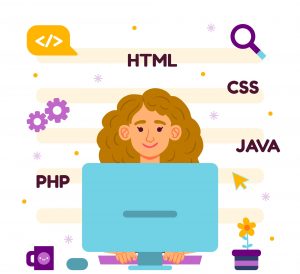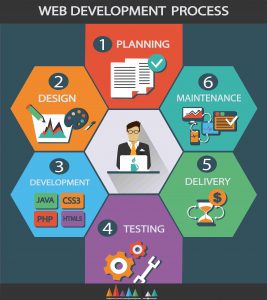Web application development has revolutionized the digital landscape, offering powerful solutions to meet diverse business needs. As you dive into this exciting field, you’ll discover how web apps have transformed the way we interact with technology. From simple static websites to complex dynamic platforms, web applications have become an integral part of our daily lives, powering everything from social media to e-commerce.
In this guide, you’ll learn the essentials of web application development, starting with the fundamental architecture that underpins these versatile systems. You’ll explore key technologies like HTML, JavaScript, and APIs that form the backbone of modern web apps.
As you progress, you’ll gain hands-on experience building your first web application, understanding crucial concepts such as front-end design, back-end programming, and database integration. By the end, you’ll have a solid foundation to begin your journey in creating responsive, user-friendly web applications that can run across various platforms and devices.

Web application architecture refers to the structural design and organization of the client-side and server-side components. It typically comprises multiple layers that work together to provide a complete solution to the end users.
The front-end is the part of a web application that’s visible and accessible to you, the user, and includes user interface (UI) elements, such as buttons, forms, and menus. The UI is the web application component that interacts with you, displays the content, and receives input. It can be implemented using various technologies, such as:
The back-end is the part of a web application that runs on the server. It typically consists of the server and the database.
The web server handles incoming client requests and sends back responses. It hosts the web application and serves HTML pages, images, and other static content. It also manages connections, sessions, and cookies and implements security mechanisms, such as SSL/TLS encryption, to protect against attacks.
The database server stores and manages data for the web application. Its functions include creating, updating, deleting, and querying data, ensuring its integrity and security. To improve the performance of web applications, database servers use caching and indexing techniques. They also implement backup and recovery mechanisms to protect against data loss and ensure its availability in the event of a failure.
Web App Architecture Components | Description |
Client-side (Front-end) | User interface, HTML, CSS, JavaScript |
Server-side (Back-end) | Web server, application logic |
Database | Data storage and management |
The role of databases in a web application is very important. The web application interacts with the database to store data and retrieve data from it. Most modern web applications are based on a database, which stores information about users, products, orders, and more, providing a central location for storing user information and business logic.
IMPORTANT!! Web applications are usually accessed by many users simultaneously, unlike traditional desktop applications that are accessed by one person at a time. As a result, web apps need the ability to handle a large number of simultaneous requests without slowing down or crashing. Web application databases use distributed architecture (multiple servers) to scale up quickly when demand increases, allowing them to handle a high volume of requests simultaneously.
Connecting a database to a web application is an important step in development. By connecting your database, you can easily add, modify, delete data, and more. The most common way is to use an Object Relational Mapper (ORM), which connects your program to the database and allows you to use it like a normal object.
HTML (HyperText Markup Language) provides the fundamental structure and content of web pages, acting as a blueprint that defines elements like headings, paragraphs, and images.
Cascading Style Sheets (CSS) govern the visual presentation, controlling layout, colors, fonts, and animations, transforming the raw HTML structure into a visually appealing user interface.
JavaScript injects interactivity into web pages, enabling features like dynamic content updates, user input handling through forms, and engaging animations, enhancing the overall user experience.

Several programming languages are commonly used for developing the server-side or backend components of web applications:
Web development frameworks and libraries provide pre-built foundations and tools to streamline the development process:
Before diving into the development process, it’s crucial to plan your application thoroughly. Start by defining your target audience and their needs. Ask yourself questions like: Who will be using the app? What are their goals? How can the app be designed intuitively? Brainstorming the audience and their mindset will help you create a user-centric experience.
Next, create wireframes or mockups to visualize the app’s structure and layout. This will help you identify the necessary components and features. Once you have a clear understanding of the app’s requirements, determine the minimum viable product (MVP) – the core features essential for the app to function. Building an MVP first allows you to release a functional product quickly and iterate based on user feedback.
Setting up a web development environment is crucial for a productive workflow. Follow these steps to create an efficient development environment:
With your development environment set up, you can start coding the frontend and backend of your web application.
For the frontend, you’ll primarily use HTML, CSS, and JavaScript. HTML provides the structure and content, CSS governs the visual presentation, and JavaScript adds interactivity and functionality.
On the backend, you can choose from various programming languages like Python (with frameworks like Django), Java (with Spring Boot), PHP (with Laravel), Node.js (with Express.js), Ruby (with Ruby on Rails), Go, or C#. These languages and frameworks will handle server-side tasks like authentication, data processing, and database integration.
As you develop your web application, it’s essential to test and debug your code regularly. Test every feature thoroughly to identify bugs that may surface under specific conditions. Well-documented code will make it easier to find and fix issues during the debugging process.
Utilize browser extensions like the Web Developer Toolbar and debugging tools provided by your chosen IDE to simplify the debugging process. Browser developer tools like Chrome DevTools and Firefox Developer Edition are also invaluable for inspecting and debugging your web application directly in the browser.
Remember, debugging is an integral part of the development process. Allocating time for thorough testing and debugging will ensure a smoother user experience for your web application.

Web application development has a significant impact on how we interact with technology, offering dynamic experiences through web browsers. This guide has provided a solid foundation to begin your journey in web app development. It covers essential aspects such as architecture, key technologies, and the step-by-step process to build your first web application.
By understanding how front-end and back-end components work together, you’re now equipped to create responsive user interfaces and robust server-side functionality.
As you continue to explore this ever-changing field, remember that practice and continuous learning are key to improving your skills. For example, if you would like to know more about a type of hybrid web app that functions as a native app as well, you should read about why progressive web apps (PWAs) are essential for mobile’s future.
The world of web development is vast, with numerous technologies and frameworks to discover. So, keep experimenting, stay curious, and don’t be afraid to tackle new challenges. With dedication and perseverance, you’ll soon be on your way to creating innovative web-based solutions that can be accessed from any device with an internet connection.
© 2024 Created by RoakonTerms and conditions